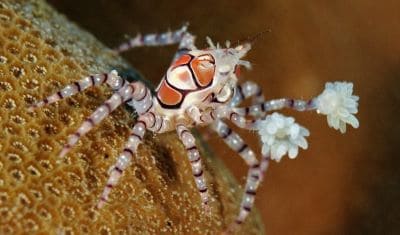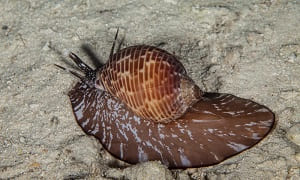Home › Sea Life › Animals › Invertebrate › Crustaceans › Crabs › Boxer Crab
Facts and Information about Boxer Crabs
[Phylum: Arthropoda] [Class: Malacostraca] [Order: Decapoda] [Family: Xanthidae]
One of the smallest examples of mud crabs also happens to be one of the most active and brightly coloured. But, it is best known for carrying anemones in its front claws.
This guide contains interesting facts and information about boxer crab (Lybia tessellata), including where they live, what they eat, and how they reproduce.
The Pom Pom Crab Distribution and Habitat
Lybia tessellata thrive best in the shallow intertidal zones (foreshores) of the tropical Indo-Pacific Ocean (especially Indonesia).
Its geographical range extends to the Red Sea, the East coast of Africa, and New Guinea. Other common nicknames for boxer crab include:
- Cheerleader crab
- Hawaiian boxer crab
- Mosaic boxer crab
- Pom-Pom crab
For the most part, you will find Lybia crabs inhabiting sand and gravel seabeds where their natural camouflage has best results. However, they also use their long, thin legs to cling on to colourful corals and tiny crevices of shallow ecosystems.
Pro Tip: Another section contains a list of weird fish names used by scientists. But, boxer crabs (Lybia tessellata) name comes from its somewhat amusing habit of carrying a sea anemone in its claw (e.g. resembling a pom pom tassel).
Boxing Crab Characteristics and Behaviour
This particular species of Lybia crab is notable for its mutualistic relationship with living sea anemones. It looks like they are carrying fluffy pom poms or wearing boxing gloves. But, in fact they hold the anemone in their claws as a defense mechanism.
The sea anemone (Actiniaria) also benefits from this special partnership. Being carried around in the crab's forward pincers (chelae) helps it capture food particles with its flowing tentacles.
Here's the thing:
Boxer crabs use more than one anemone species. But, this kind of mutual bonding tends to occur most often with a zooxanthellate called Triactis producta.
They don't need to carry the cnidarians for survival. Instead, boxer crabs use them to gather food particles (like a mop) and to defend themselves against their main predator - gobies fishes.
A pom-pom crab (also called a boxing crab) will wave the living hydroids around to try and deter an aggressor. So, because they are alive, the anemone's tentacles will be armed with stinging cells (called cnidocytes).
Fun Fact: Sometimes, the boxing crab will carry a substitute organism in place of an anemone. Typical examples include sea sponges (phylum Porifera) and small particles of broken coral.
 How Big is a Boxer Crab (Lybia tessellata)?
How Big is a Boxer Crab (Lybia tessellata)?
In general, the width of the tiny pom pom crab rarely exceeds two and a half centimetres (one inch wide).
The stalk of the eye is short and its four-sided carapace (shell) is somewhat trapezoidal in appearance.
But the bottom line is this:
Unlike most decapod crabs, the major chelipeds in boxer crabs are slim and narrow, sometimes bearing nine (9) spines.
Despite being larger than the chelipeds, the front walking legs are noticeably smaller in size - when compared to the other three pairs. These tend to be speckled, with short hair, and have white spots that contrast with several dark bands of transverse lines.
What Do Pom-Pom Crabs Eat?
It's fair to say that the boxer crab is a timid creature. It spends most of its life hidden inside tiny crevices and only ventures out into the open for short bursts to feed.
During these periods of hunting, it has adapted the function of its second pair of legs. Even though its front claws may be busy carrying the stinging hydroids, it can use the next row of pincers to rip off and tear up small pieces of food from larger chunks.
Most crabs are omnivorous scavengers. In other words, besides eating vegetable matter, other crabs, and small fishes (alive, dead, or decaying), they will also feed on.
Lybia Crab Reproduction Process
Most crabs display sexual dimorphism. As a result, it's quite easy to differentiate males (with larger claws) from females. In fact, males use enlarged chela for communication and to attract a mating partner.
In addition, the abdomen of crustaceans (the pleon) tends to be narrower and more of a triangular shape in male crabs. Whereas, female crabs tend to have a broad, somewhat rounded abdomen. This is the area where they will eventually brood fertilised eggs.
In case you were wondering:
When female crabs lay their eggs, including land crabs, they need to do it in water. Thus, she will carry the eggs on her body, inside the abdominal sac for about two (2) weeks, until they hatch.
Some baby crabs hatch and look like small adults straight away - but not all. Instead, most newly hatched crabs (zoea) tend to be tiny, transparent creatures absent of any fully formed legs drifting around at the upper column of the water.
They will shed their exterior covering several times, through a process called metamorphosis, before they develop into the adult form.
Fun Fact: A fading moon is the signal for female crabs to enter the ocean and start laying (up to 100,000 eggs at a time). Yet, the blue crab is capable of carrying up to two (2) million eggs in the brooding season.
Boxer Crab Predators and Threats
The IUCN Red List of Endangered Species has the status of Lybia tessellata as being Not Evaluated (NE). Even so, the typical predators of tiny boxer crabs include gobies and other small rock dwelling fishes.
Pro Tip: Another section contains information about keeping fish species in a reef aquarium. In general, aquarists who keep pom-pom crabs in captivity will use a small tank for easier viewing - especially when there are no bright tank lights in use.
Related Information and Help Guides
- Crab Species Facts and Information with Examples
- Hermit Crab Fun Facts and Information with Pictures
- Mantis Shrimp Habitat and Geographic Range
- Sea Anemone Shrimp Facts and Information
- The Ecological Role of Copepods and Krill in Oceanic Environments
Note: The short video [2:11 minutes] presented by 'Nature on PBS' contains fun and interesting footage of the boxer crab using sea anemones to fend off a pufferfish.
